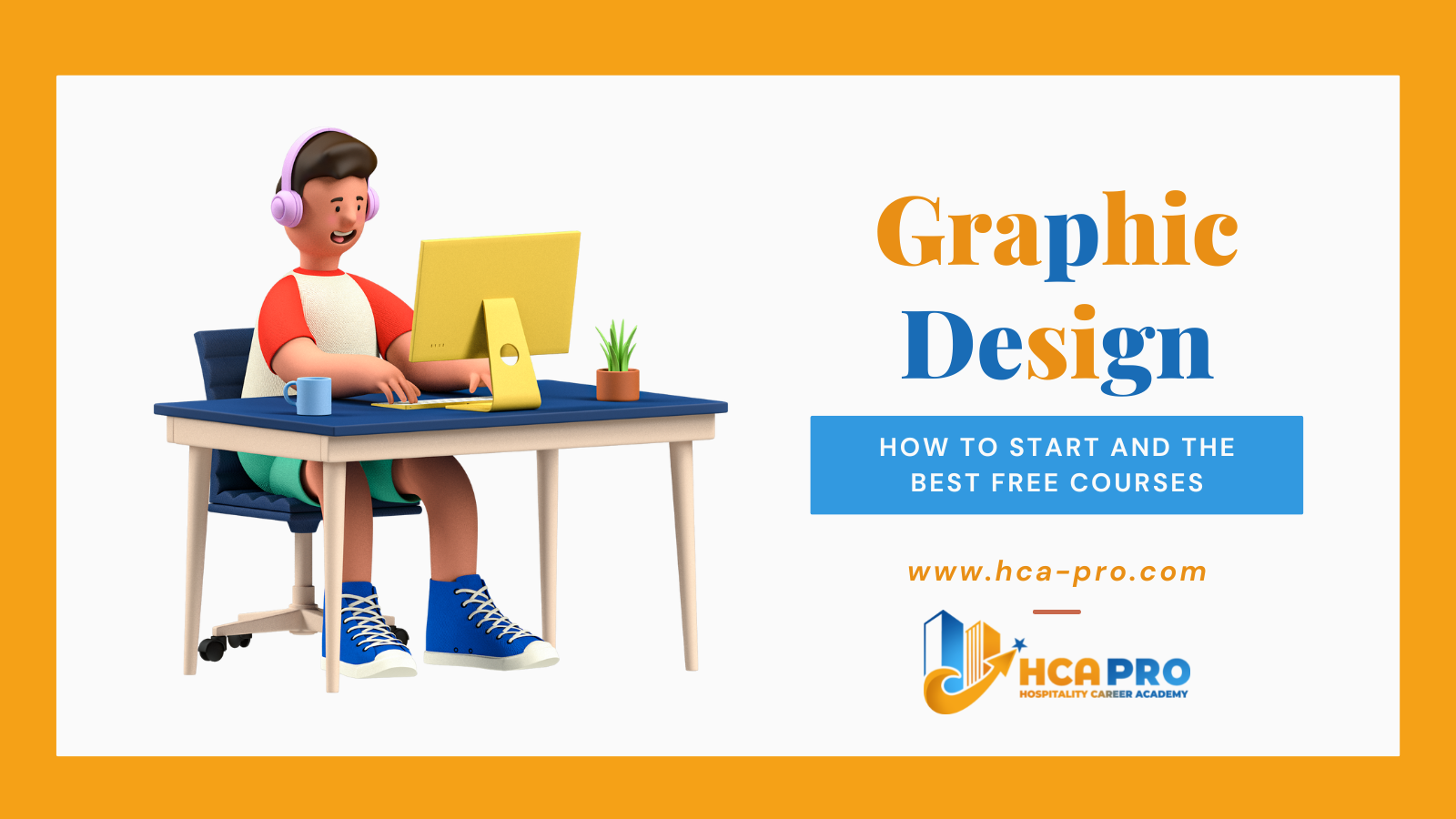
Graphic Design: How to Start and the Best Free Courses
Graphic design is the art and practice of creating visual content to communicate information and ideas to a specific audience. It involves using typography, imagery, color, and layout to create visual compositions that are effective in conveying a message or achieving a specific objective. Graphic designers may work on a variety of projects, including creating logos, packaging, print materials, websites, and marketing campaigns. They use computer software such as Adobe Creative Suite to create and manipulate visual elements and may work with clients to understand their needs and develop design solutions that meet their goals. Graphic design is a broad field that encompasses many different specialties, including branding, interface design, user experience design, and motion graphics.
What are the 7 types of graphic design?
There are many different types of graphic design, and the specific types that are most relevant can vary depending on the industry and the specific project. Some common types of graphic design include:
-
Branding design: This type of design involves creating visual elements for a brand, including logos, color schemes, typography, and messaging.
-
User interface (UI) design: This type of design focuses on creating effective and user-friendly interfaces for websites and mobile apps.
-
User experience (UX) design: UX design involves creating designs that enhance the overall user experience of a product or service.
-
Print design: This type of design involves creating visual elements for printed materials, such as brochures, flyers, posters, and magazines.
-
Advertising design: Advertising design involves creating visual elements for advertisements, such as banner ads, billboards, and print ads.
-
Packaging design: Packaging design involves creating visually appealing packaging for products, including the design of the physical packaging as well as any graphics or text that appear on it.
-
Motion graphics: This type of design involves creating graphics and visual effects that are used in video and film projects.
Branding design
Branding design involves creating visual elements that are used to identify and distinguish a brand from its competitors. This can include creating a logo, choosing a color scheme and typography, and developing messaging and visual imagery that reflects the brand's values and personality. The goal of branding design is to create a cohesive and consistent visual identity that reflects the brand's mission and differentiates it from competitors.
In creating a brand's visual identity, designers may work with the brand to understand its target audience, values, and objectives, and then use this information to develop design elements that will be effective in communicating the brand's message and resonating with its target audience.
Branding design can be applied to a wide range of products and services, including websites, packaging, advertising, and physical products. A strong brand identity can help a company establish itself in the marketplace, build customer loyalty, and stand out from competitors.
User interface (UI) design
User interface (UI) design involves creating the visual elements that make up the interface of a website or application. This includes the layout, color scheme, typography, and other visual elements that make up the user experience. The goal of UI design is to create an interface that is easy to use and navigate and that effectively communicates information to the user.
To create an effective UI, designers must consider the needs and goals of the user, as well as the overall look and feel of the interface. They must also consider the technical limitations of the platform on which the interface will be used.
UI designers may use a variety of tools and techniques to create their designs, including wireframing and prototyping software, as well as computer graphics software such as Adobe Creative Suite. They may also work closely with user experience (UX) designers and developers to ensure that the interface is functional and intuitive for users.
User experience (UX) design
User experience (UX) design involves creating designs that enhance the overall user experience of a product or service. This can include the design of websites, mobile apps, software, and physical products. The goal of UX design is to create a seamless and enjoyable experience for users, ensuring that they can easily accomplish their goals and tasks within the product or service.
To create an effective UX, designers must consider the needs and goals of the user, as well as the overall look and feel of the product or service. They must also consider the technical limitations of the platform on which the product or service will be used.
UX designers may use a variety of tools and techniques to create their designs, including user research, wireframing and prototyping software, and computer graphics software such as Adobe Creative Suite. They may also work closely with UI designers and developers to ensure that the product or service is functional and intuitive for users.
Print design
Print design involves creating visual elements for printed materials, such as brochures, flyers, posters, and magazines. The goal of print design is to create visually appealing and effective materials that communicate information and ideas to the intended audience.
To create an effective print design, designers must consider the size and format of the printed material, as well as the intended audience and the message or information that needs to be conveyed. They must also consider the technical limitations of the printing process, such as the available colors, paper stock, and printing methods.
Print designers may use a variety of tools and techniques to create their designs, including computer graphics software such as Adobe Creative Suite. They may also work closely with clients to understand their needs and develop design solutions that meet their goals.
Advertising design
Advertising design involves creating visual elements for advertisements, such as banner ads, billboards, and print ads. The goal of advertising design is to create visually appealing and effective ads that capture the attention of the intended audience and persuade them to take a desired action, such as purchasing a product or service.
To create an effective advertising design, designers must consider the size and format of the ad, as well as the intended audience and the message or information that needs to be conveyed. They must also consider the technical limitations of the medium in which the ad will be displayed, such as the available colors, resolution, and file size.
Advertising designers may use a variety of tools and techniques to create their designs, including computer graphics software such as Adobe Creative Suite. They may also work closely with clients to understand their needs and develop design solutions that meet their goals.
Packaging design
Packaging design involves creating visually appealing and functional packaging for products. This can include the design of the physical packaging, as well as any graphics or text that appear on the packaging. The goal of packaging design is to create packaging that effectively communicates information about the product, protects the product during transportation and storage, and is attractive to the intended audience.
To create an effective packaging design, designers must consider the size and shape of the product, as well as the materials and printing methods that will be used for the packaging. They must also consider the needs and preferences of the intended audience, as well as any legal or regulatory requirements that must be met.
Packaging designers may use a variety of tools and techniques to create their designs, including computer graphics software such as Adobe Creative Suite. They may also work closely with clients to understand their needs and develop design solutions that meet their goals.
Motion graphics
Motion graphics is a type of graphic design that involves creating graphics and visual effects that are used in video and film projects. The goal of motion graphics is to enhance the visual appeal of the video or film and communicate information to the viewer through the use of animation, typography, and other visual elements.
To create effective motion graphics, designers must consider the format and length of the video or film, as well as the intended audience and the message or information that needs to be conveyed. They must also consider the technical limitations of the medium, such as the available colors, resolution, and frame rate.
Motion graphics designers may use a variety of tools and techniques to create their designs, including computer graphics software such as Adobe After Effects and Cinema 4D. They may also work closely with video editors, animators, and other team members to ensure that the motion graphics are integrated seamlessly into the final video or film.
How to learn graphic design?
There are many different ways to learn graphic design, and the best approach will depend on your individual goals and needs. Here are a few options to consider:
-
Enroll in a formal education program: Many colleges and universities offer graphic design programs that can provide a comprehensive education in the field. These programs typically cover a wide range of topics, including design principles, software skills, and professional practice.
-
Take online courses or tutorials: There are many online resources available for learning graphic design, including courses and tutorials on specific software or design principles. These can be a good option for learning at your own pace and on your own schedule.
-
Get hands-on experience: Practicing graphic design on your own and working on real-world projects can be a great way to learn and improve your skills. You can create your own design projects or volunteer to work on projects for non-profit organizations or small businesses.
-
Seek out mentorship or internships: Working with a mentor or interning at a design firm can provide valuable hands-on experience and guidance as you learn the field.
-
Stay up to date: The field of graphic design is constantly evolving, so it's important to stay up to date on the latest trends and techniques. Reading industry publications, attending design conferences and workshops, and networking with other designers can all be helpful in staying current.
Best free graphic design courses
There are many free graphic design courses available online that can help you learn the skills you need to become a graphic designer. Some options include:
-
Coursera: Coursera offers a wide range of graphic design courses, including ones on logo design, visual design, and typography. Many of these courses are free to audit, although some require a fee for a certificate.
-
Khan Academy: Khan Academy offers a variety of free graphic design courses, including ones on design principles, layout design, and digital drawing.
-
Udemy: Udemy has a wide range of graphic design courses that are available for free or at a discounted price.
-
Alison: Alison offers a variety of free graphic design courses, including ones on design principles, typography, and illustration.
-
EdX: edX has a number of free graphic design courses available, including ones on design thinking, visual communication, and user experience design.
-
CreativeLive: CreativeLive offers a variety of free and paid graphic design courses, including ones on branding, typography, and design software.
-
Canva Design School: Canva Design School is a free online resource that offers courses on graphic design, including ones on color theory, composition, and design principles.
-
Google's Graphic Design Certificate: Google offers a free online graphic design certificate program through Coursera. The program covers topics such as design principles, user experience design, and visual design.
These are just a few examples of the many free graphic design courses that are available online. It's a good idea to do some research and compare different options to find the course that best fits your needs and learning style.
We can recommend EngProsoft for any Graphic Design Services
